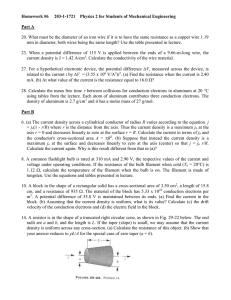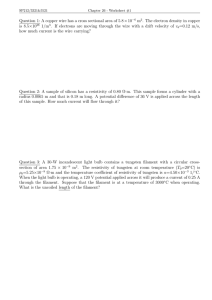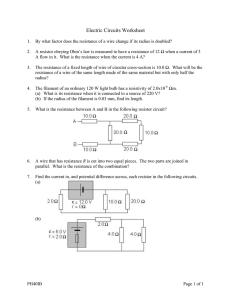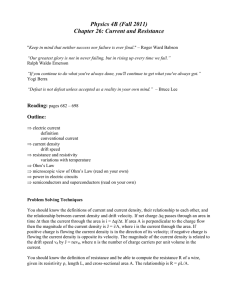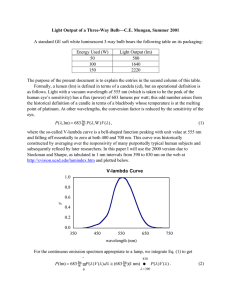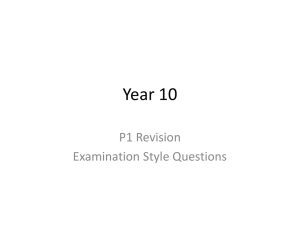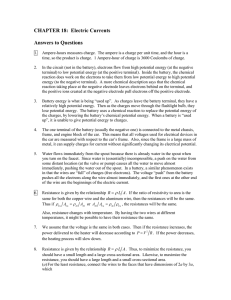Resistance_ISAkg_amended
advertisement
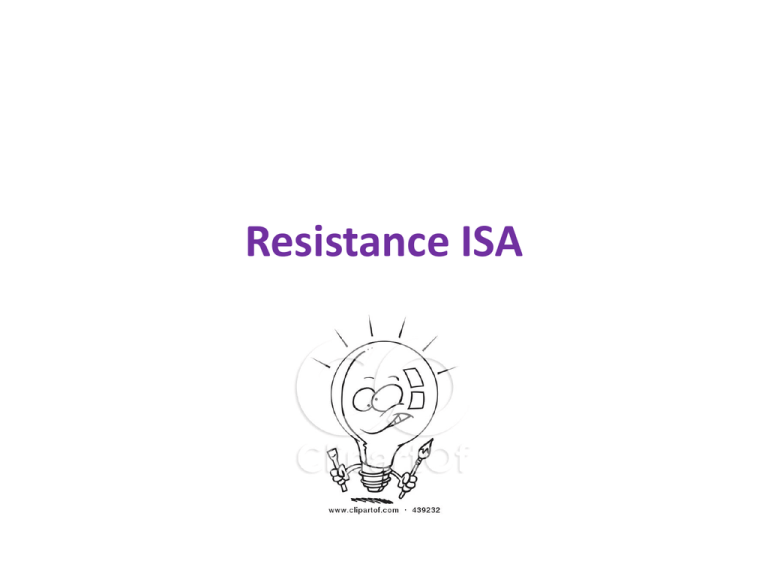
Resistance ISA Here’s the plan: • Thurs 20th – Graph of current against resistance. Theory of heat/resistance. • Friday 21st – Background, context, research, CRN. • Mon 24th – CRN (continued) Table and Paper 1 Prep • Tues 25th – Paper 1 • Wed 26th – Practical (am), Graph (pm) • Fri 28th – Paper 2 Prep • Mon 1st – Paper 2 Prep (again!) • Tues 2nd – Paper 2? (it’s a pm lesson) • Wed 3rd – Paper 2? The Background Filament lamp symbol The filament lamp is a common type of light bulb. It contains a thin coil of wire called the filament. This heats up when an electric current passes through it and produces light as a result. Higher tier only An electric current flows when electrons move through a conductor, such as a metal wire. The moving electrons can collide with the ions in the metal. This makes it more difficult for the current to flow, and causes resistance. As the temperature increases, the metal ions vibrate more. There are more collisions with the electrons and so the resistance increases. Electricity in wires is a flow of electrons along the wire. As the electrons move along the wire they collide with the copper atoms (ions). These collision make the atoms vibrate more…which makes the metal hotter. This in turn, leads to more collisions, and therefore more resistance. Resistance is a measure of how much a material ‘tries’ to stop electricity passing through it. The Context Part 1: When you first switch on a filament bulb: 1. The filament wire is cool. 2. The resistance is low, so this causes a high current to flow. 3. The high current leads to a ‘surge’, which in turn causes resistance to increase. 4. The surge only lasts 0.1 s, but causes the filament wire to heat up suddenly, called ‘thermal shock’. 5. This may cause the wire to melt and break at a weak point. The Context Part 2 • Consumers (that means ordinary people) want light bulbs that can be switched on and off thousands of times without the bulb blowing. • Light bulb manufacturers need to know how the resistance in a bulb changes as the current changes. • HT: This will help them design bulbs that can withstand the high resistance that occurs when bulbs suddenly heat up when first switched on, to avoid them blowing. Your hypothesis… • You need to come up with this on your own. • Basic format: ‘I think that if I change ‘x’ then ‘y’ will ………..’ • Hint: Mention current and resistance, increase and/or decrease. Research • Use the 4 resources provided to get further information and give you ideas on how to test your hypothesis. • You may also want to look back at the practical we did last week. Candidate Research Notes • • • • • • Hypothesis: ‘I think that if I change ‘x’ then ‘y’ will ………..’ • Sources: Where did you find your information. You must be specific – the full website address / title and author of the textbook to get 3 marks you need to be able to explain why you chose one source, what was better about it, why you rejected the other one and what was less good about it. Method: Write up neatly as a list of notes to remind you in the exam Equipment: A list of what you’ll need Risk Assessment: any possible hazards / risks /controls - table Context: Light Bulb Manufacturers. Light bulbs need to able to withstand being switched on and off hundreds of times without the bulb blowing. Planning your method…. Method A short list of instructions in note form in order, not written in sentences- spellings must be perfectly correct!!! The equipment that is needed for the experiment - a list - spellings again! What are your independent, dependent and control variables? Risk Assessment What are the potential Hazards, Risks and Control Measures involved in the experiment – put it in a table!

